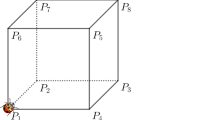Abstract
A recursive functiong is augmenting ifg(n) ≥n for alln. Ag-constructor for a setA is a Turing machine that on inputn outputs some element ofA betweenn andg(n), inclusive, if such an element exists. Ag-generator forA outputs all elements ofA betweenn andg(n). Ag-detector merely determines whether there exist any elements in the given range. Total constructors (generators, detectors) always halt, and indicate whether or not any elements exist in the set in the given range; partial machines need not halt in the event that no such elements exist.
We characterize the classes of sets having each of these types of machines. We also establish that the problems of determining, for a given recursively enumerable setA and augmenting functiong, whetherA has a total or partialg-generator or a totalg-constructor or detector are all ∑3-complete; and we determine, for fixedg, the relationships among the classes of sets having these different types of machines.
Similar content being viewed by others
References
M. Abadi, E. Allender, A. Broder, J. Feigenbaum, and L. Hemachandra. On generating solved instances of computational problems. InProceedings of CRYPTO 88, August 1988.
E. Bach. How to generate random integers with known factorization. InProceedings of the 15th Annual ACM Symposium on Theory of Computing, pages 184–188, 1983.
M. Blum and R. Impagliazzo. Generic oracles and oracle classes. InProceedings of the 28th Annual Symposium on Foundations of Computer Science, pages 118–126, October 1987.
J. Feigenbaum, R. J. Lipton, and S. R. Mahaney. A completeness theorem for almost-everywhere invulnerable generators. AT&T Bell Laboratories Technical Memorandum, February 1989.
L. Hemachandra, E. Allender, J. Feigenbaum, M. Abadi, and A. Broder. Generating hard, certified elements of NP-complete sets. AT&T Bell Laboratories Technical Memorandum, February 1989.
D. T. Huynh. Efficient detectors and constructors for simple languages.International Journal of Foundations of Computer Science, 2(3): 183–205, September 1991.
M. R. Jerrum, L. G. Valiant, and V. V. Vazirani. Random generation of combinatorial structures from a uniform distribution.Theoretical Computer Science, 43:169–188, 1986.
B. Krishnamurthy. Constructing test cases for partitioning heuristics.IEEE Transactions on Computers, 36(9): 1112–1114, September 1987.
B. D. McKay and N. C. Wormald. Uniform generation of random regular graphs of moderate degree.Journal of Algorithms, 11:52–67, 1990.
A. Nijenhuis and H. S. Wilf.Combinatorial Algorithms. Academic Press, New York, 1978.
M. G. Pilcher and R. L. Rardin. A random cut generator for symmetric traveling salesman problems with known optimal solutions. Technical Report CC-87-4, Institute for Interdisciplinary Engineering Studies, Purdue University, February 1987.
L. A. Sanchis. Test case construction for NP-hard problems. InProceedings of the 26th Annual Allerton Conference on Communication, Control, and Computing, pages 711–720, September 1988.
L. A. Sanchis and M. A. Fulk. On the efficient generation of language instances.SI AM Journal on Computing, 19(2):281–296, April 1990.
R. I. Soare.Recursively Enumerable Sets and Degrees. Springer-Verlag, New York, 1987.
G. Tinhofer. On the generation of random graphs with given properties and known distribution.Applied Computer Science, 13:265–297, 1979.
Author information
Authors and Affiliations
Additional information
Part of this work was done while the author was an AT&T Bell Labs Scholar at the Computer Science Department of the University of Rochester.
Rights and permissions
About this article
Cite this article
Sanchis, L.A. On the effective generation of set elements within specified ranges. Math. Systems Theory 26, 327–341 (1993). https://doi.org/10.1007/BF01189853
Received:
Revised:
Accepted:
Published:
Issue Date:
DOI: https://doi.org/10.1007/BF01189853



